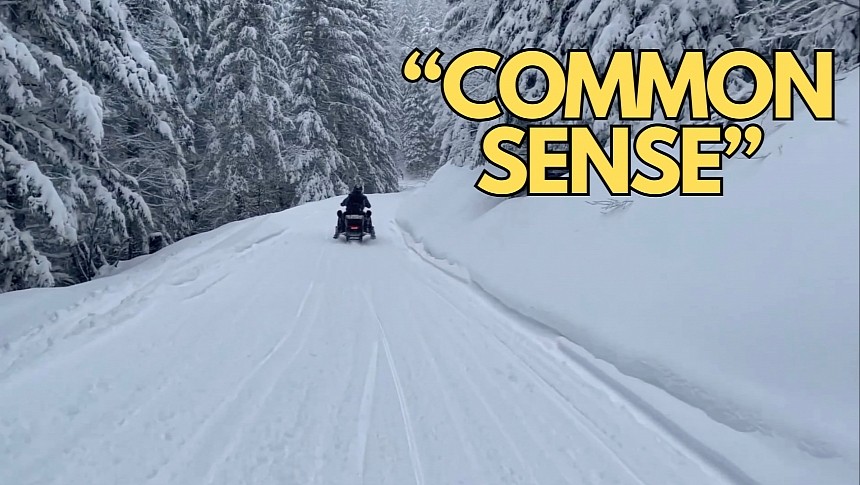If a road looks dangerous, don't take it. It's common sense. No matter what Google Maps, Apple Maps, Waze, or any other sat-nav software you may be using, if a road doesn't look safe, don't take it.
A young driver received a life-saving lesson on New Year's Day when he attempted to reach a cabin using a snowmobile track because it was the route suggested by Google Maps.
The Idaho driver, who was in his mid-20s, according to the Search and Rescue at the Summit County Sheriff's Office, used Google Maps to find the destination when he was told that the Mirror Lake Highway was closed. The information was partially accurate, though the highway was closed at another point.
However, Google Maps suggested an alternate route that included a Forest Service road covered in snow. It was obvious from the very beginning that a Subaru Crosstrek shouldn't use a snowmobile track instead of a paved road, but the driver decided to take the route, trusting Google Maps blindly.
The rescuers claim they were surprised to see the Subaru going that far. The vehicle eventually got stuck on a road sector with soft snow, where continuing the trip was impossible. The driver was fortunate enough to have a cellular signal, so they texted 911 and waited for help. Meanwhile, he had no other option than to face the brutally cold temperatures, with the rescuers claiming it was 16 degrees (about -9 degrees Celsius) when they found the guy. It was also windy, so the "feels like" temperature was much lower.
Rescuing the man with the appropriate equipment wasn't that hard, but no tow company accepted a job in the mountains, so pulling the vehicle out of the snow was the real challenge. The Summit County Search and Rescue responders decided to make an exception and help the driver get out of the snow and return to safety before leaving the region. They helped pull the vehicle out of the snow, though their policy is to save the poor fellow behind the wheel and let them find a tow company to pull their cars.
The driver said he ended up stuck in the snow because he followed Google Maps and never spotted a sign telling them the road was closed or not suitable for road vehicles. Truth be told, you need a sign to tell you a snow-covered road should be avoided, especially when you're all alone, and you can't even see other vehicle tracks on it.
The rescuers also have a good piece of advice for anyone who believes Google Maps can help them find a destination faster. Use common sense instead of turn-by-turn navigation, as it might get you to the address with a few minutes delay, but you wouldn't risk your lives on the way there.
The Idaho driver, who was in his mid-20s, according to the Search and Rescue at the Summit County Sheriff's Office, used Google Maps to find the destination when he was told that the Mirror Lake Highway was closed. The information was partially accurate, though the highway was closed at another point.
However, Google Maps suggested an alternate route that included a Forest Service road covered in snow. It was obvious from the very beginning that a Subaru Crosstrek shouldn't use a snowmobile track instead of a paved road, but the driver decided to take the route, trusting Google Maps blindly.
The rescuers claim they were surprised to see the Subaru going that far. The vehicle eventually got stuck on a road sector with soft snow, where continuing the trip was impossible. The driver was fortunate enough to have a cellular signal, so they texted 911 and waited for help. Meanwhile, he had no other option than to face the brutally cold temperatures, with the rescuers claiming it was 16 degrees (about -9 degrees Celsius) when they found the guy. It was also windy, so the "feels like" temperature was much lower.
Rescuing the man with the appropriate equipment wasn't that hard, but no tow company accepted a job in the mountains, so pulling the vehicle out of the snow was the real challenge. The Summit County Search and Rescue responders decided to make an exception and help the driver get out of the snow and return to safety before leaving the region. They helped pull the vehicle out of the snow, though their policy is to save the poor fellow behind the wheel and let them find a tow company to pull their cars.
The driver said he ended up stuck in the snow because he followed Google Maps and never spotted a sign telling them the road was closed or not suitable for road vehicles. Truth be told, you need a sign to tell you a snow-covered road should be avoided, especially when you're all alone, and you can't even see other vehicle tracks on it.
The rescuers also have a good piece of advice for anyone who believes Google Maps can help them find a destination faster. Use common sense instead of turn-by-turn navigation, as it might get you to the address with a few minutes delay, but you wouldn't risk your lives on the way there.















